Thinking about building a new tech product? Hold that thought for a second.
Before you pour time, money, and caffeine into full-scale MVP application development, let’s talk strategy. The smartest startups don’t launch with everything built out. They start with the essentials, test quickly, and adapt fast. That’s where a Minimum Viable Product (MVP) comes in.
It’s not just a startup buzzword. It’s a proven MVP business approach. Companies like Airbnb, Dropbox, Instacart, and Pager didn’t launch with a polished, investor-ready platform. They began lean, learned fast, and scaled smart.
No one wants to invest in a product only to find out there’s zero market demand. A Minimum Viable Product helps you avoid that trap. It gives you a way to validate your idea, attract early users, and get real-world feedback without burning through your runway.
Whether you’re just starting out or already on your third startup, knowing how to build a Minimum Viable Product at low cost and high speed can make all the difference. And with AI in your toolkit, the MVP development framework gets even smarter. It helps you manage requirements, speed up MVP project timelines, and tighten feedback loops.
In this blog, we’ll show you how to develop an MVP that saves time, cuts costs, and works. Let’s dive in.
What is a Minimum Viable Product (MVP)?
A Minimum Viable Product is a basic version of your product. It includes the core features needed to collect early feedback from users and validate market fit.
The goal of developing an MVP is to launch quickly, learn from real users, and avoid wasting time and money on building the full product too soon.
Eric Ries, the innovator who popularized this idea, described the MVP as:
A new product version is designed to gather the greatest amount of validated learning from customers with minimal effort.

MVP projects are not about creating a “perfect” product or developing just the “minimum” functionality. Instead, they're about testing your product’s core hypothesis and gaining feedback from users as early as possible. Use insights from your MVP to shape future iterations. This is how you build something people truly want.
To explore this concept in greater depth, check out our detailed guide: What is Minimum Viable Product (MVP)? Explained How to Build, Benefits, Examples & More.
How to Build an MVP at Low Cost and High Speed?
Building an MVP quickly and affordably requires careful planning and smart execution. Here's a breakdown of the key steps to create an MVP efficiently:
Define Your Core Problem and Solution
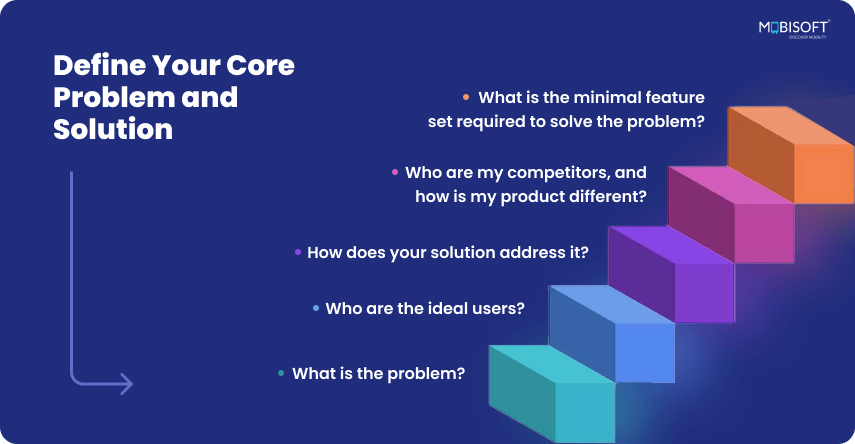
Start by clearly defining the problem you're solving. Understand your target users and their needs. Without this, creating an MVP with real value is impossible. Focus on the core value proposition of your product.
- What is the problem?
- How does your solution address it?
- Who are the ideal users?
- What is the minimal feature set required to solve the problem?
- Who are my competitors, and how is my product different?
Don’t get distracted by secondary features. Developing an MVP means focusing only on what will help your users solve the problem most efficiently.
Identify Your Key Features
Once you know the core problem and solution, focus on the essential features needed to make your product functional and testable. These should solve the problem with no extra frills. Even a simple MVP app with user registration, basic functionality, and a minimal UI can be enough.
Don’t overwhelm your users with excessive features. Use the 80/20 rule. Focus on the 20% of features that provide 80% of the value. The following methods can help during the MVP feature selection phase:
- Feature prioritization matrix
- MoSCoW method (Must-have, Should-have, Could-have, Won’t-have)
- User story mapping
Choose the Right Technology Stack
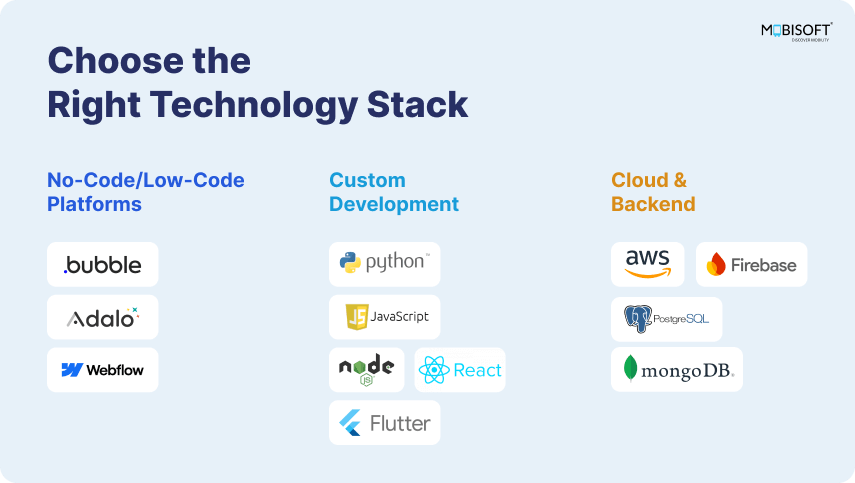
Choosing the right tools is key to building an MVP efficiently. Go for lightweight, scalable, and cost-effective technologies. Open-source frameworks and no-code or low-code MVP platforms are excellent for MVP building on a budget. Partnering with experts offering comprehensive software development services ensures your MVP is built on a solid and future-ready foundation.
Common choices:
- No-Code/Low-Code Platforms: Bubble, Adalo, Webflow (for rapid development)
- Custom Development: Python, JavaScript, Node.js, React, Flutter (for scalability)
- Cloud & Backend: AWS, Firebase, PostgreSQL, MongoDB
This tech stack allows you to build MVP apps faster, without compromising future scalability. For a deeper look into how to pick the best technologies for your MVP, check out MVP Development: The Ultimate Guide to Selecting the Right Tech Stack.
Focus on Iteration Over Perfection
Don’t aim for perfection in your first release. The first version of your Minimum Viable Product should be built fast and tested early.
Launch early. Learn from user feedback and improve as you go. Plan for rapid sprints with agile methodology. Focus on specific improvements in each release. This ensures you're building a product that users want.
Popular agile methodologies adopt:
- Scrum: Short sprints for quick MVP releases.
- Kanban: Continuous updates with flexible priorities.
- Rapid prototyping: Frequent user feedback to refine the product.
Testing and Gathering Feedback
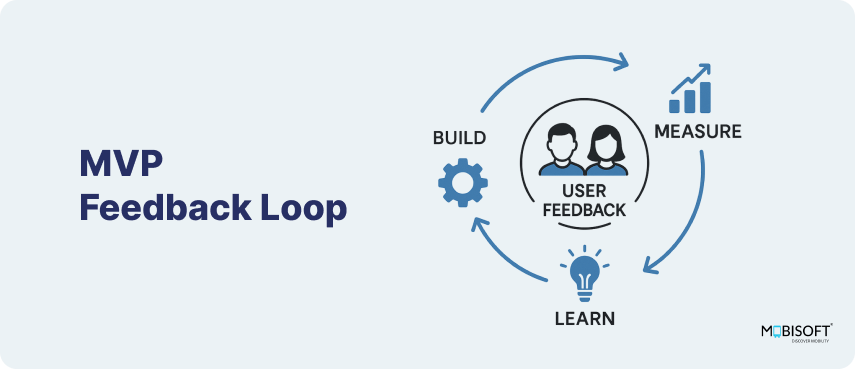
Once your MVP is ready, it's time to see how real users interact with it. Their feedback is gold. It tells you what’s working and what needs fixing. Testing and feedback loops should be integral to your MVP process:
- User Testing: Conduct usability tests to understand pain points. Find out areas of improvement.
- Analytics: Track clicks, drop-offs, and time spent. Numbers don’t lie.
- Surveys & Interviews: Talk to users. Ask about their experience. Quick chats or short surveys can reveal what users think and want next.
This loop of feedback and improvement is what turns a basic MVP into a product users love.
MVP Launch & Post-Launch Optimization
You are ready to make your MVP live once you make improvements based on the feedback. But an MVP launch is just the beginning. Post-launch optimization plays a key role in your long-term success.
- Monitor User Behavior
Keep tracking how users interact with your product in real time. Look for patterns, spot issues early, and understand what’s working well. - Iterate Based on Feedback
Take what you learn and apply it to future updates. Whether it’s refining a feature, fixing a bug, or adding something new, every improvement should bring your MVP closer to what your users need. - Engage with Your Users
Stay connected through newsletters, surveys, or community platforms. Regular interaction builds stronger relationships and gives you a steady stream of insights. - Marketing and Growth Strategy
Focus on building your user base. Use social media and content marketing. Build a creative growth strategy to attract more users.
Your MVP journey doesn't end with launch. It evolves with every user interaction, every update, and every new opportunity to grow.
Common Mistakes to Avoid When Developing an MVP
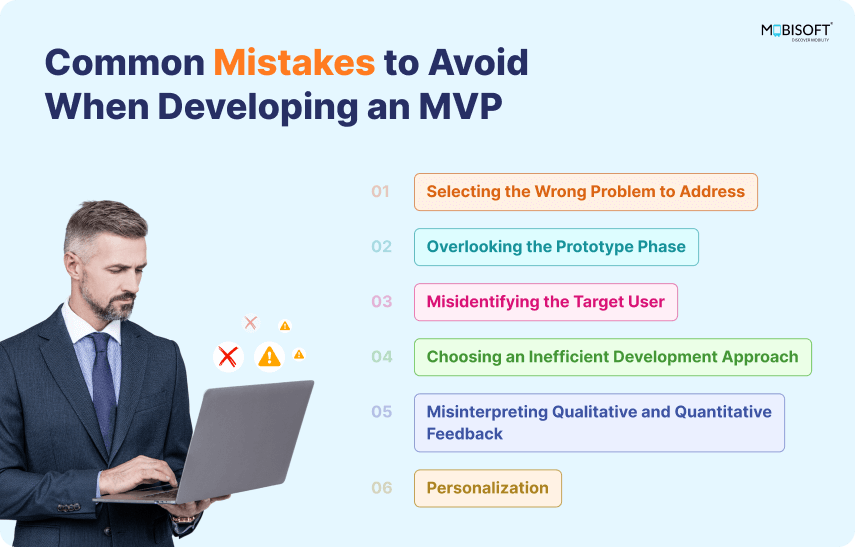
Today, the digital world moves fast. It’s the game of “Survival of the Fittest.” That’s why building an MVP is a smart way to test your concept without burning through time or money. But here’s the catch: many MVP projects still fail, not because the idea is bad, but due to simple, avoidable mistakes. Knowing what not to do can be just as critical as understanding how to build a Minimum Viable Product that works.
Selecting the Wrong Problem to Address
Before diving into MVP development, take a step back and ask, “Is this problem really worth solving?”
Startups should dig into the pain points they’re targeting and ask:
- Who exactly is this for?
- What problem are we solving?
- Is our solution practical and effective?
Trying to solve everyone’s problem often means solving none. A successful MVP in business targets a specific user group and aligns the product’s core value around their needs. Once you’ve got that alignment, it’s time to test your MVP app idea under real-world conditions to validate the opportunity before you build.
Overlooking the Prototype Phase
Have you ever imagined building a bungalow without a blueprint or visual model? Jumping straight into MVP application development without prototyping is a risky move. A prototype bridges the gap between idea and execution. It shows how the user experience will work.
Think of prototyping as creating a Minimum Viable Prototype for your Minimum Viable Product. While it doesn’t need to be fully operational, it should be functional enough to validate design, experience, and core usability.
The prototype should capture the essence of your MVP project. The “what” (Minimum) and “how” (Viable). By following the Goldilocks principle, not too complex and not too simple, your prototype can effectively communicate your MVP vision and reduce waste in development cycles.
Misidentifying the Target User
Many MVPs fail because they don't address the needs of the right audience better than existing alternatives. Once your MVP prototype is ready, collecting feedback from the right people becomes a cornerstone of success.
Not everyone is your user. Getting feedback from friends or family can lead to misleading conclusions unless they match your target market. Wrong input can cause unnecessary pivots or derail a strong MVP concept.
Real feedback from actual users is essential when you’re trying to develop an MVP that will scale. It uncovers usability issues and highlights areas of improvement. A continuous loop of testing, learning, and improving is how you build a MVP app that’s truly market-ready.
For example, Amazon constantly improves its checkout flow by listening to users. During testing, they found people were leaving their carts because the interface was messy and the call-to-action buttons weren’t clear. After simplifying the design and highlighting the "Buy Now" button, they saw higher conversions and fewer abandoned carts.
Choosing an Inefficient Development Approach
A clear development approach is vital to deliver your Minimum Viable Product on time and on budget. Many startups fall short because they lack a sound strategy for their MVP build. That’s why working with a team that provides tailored IT solutions & services can dramatically improve your MVP’s success rate by aligning technology with business goals.
There are two main ways to go about it:
- Waterfall is a step-by-step process. You finish one phase before moving on to the next.
- Agile is more flexible. It breaks development into smaller parts, allowing regular testing and improvements along the way.
Agile is often the better choice for MVP development. It helps you adapt quickly, get to market faster, and lower the risk of building something people don’t want.
Misinterpreting Qualitative and Quantitative Feedback
Getting feedback is important, but knowing what kind of feedback you're collecting matters just as much. There are two main types:
- Qualitative feedback helps you understand user behavior, spot design issues, and learn how people feel about your product.
- Quantitative feedback focuses on numbers. It looks at things like success rates, errors, and overall performance.
| Aspect | Qualitative Feedback | Quantitative Feedback |
| Questions Answered | Why? | How many? How much? |
| Objectives | Identify usability issues, improve design | Measure usability, compare performance, ROI |
| Used When | Anytime (prototype, redesign, final product) | When a product is fully functional |
| Result | Subjective insights from user behavior | Statistical data for performance evaluation |
A balanced approach that includes both qualitative and quantitative insights leads to better decisions and increases your chances of building a successful product.
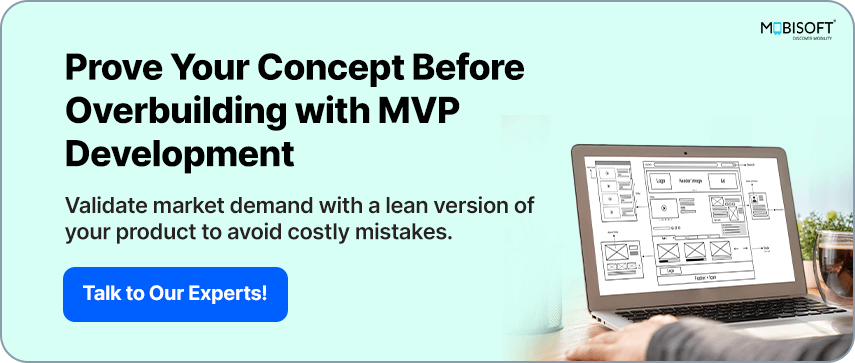
How AI Can Empower the Building of an MVP
Artificial Intelligence is transforming how we build MVPs, especially in areas like requirements gathering, rapid development, and continuous iteration. If you're exploring how to build a Minimum Viable Product with speed and precision, AI can significantly boost your efforts. Here's how our AI-enabled MVP development approach can create real impact:
AI-Driven Requirements Management
AI tools help gather and prioritize requirements by analyzing market data, user feedback, and competitor products. AI not only enables rapid identification of trends and patterns, helping you focus on what truly matters, but also drafting detailed requirements, design guidelines, and improving the prioritization of features.
- AI-generated Ideas to Market Trends (ChatGPT-4o Mini, Perplexcity AI) : AI analyzes large sets of user data to determine what features are most in demand, ensuring you’re building a product that aligns with targeted user needs enabling comparative analysis of new ideas to past market trends, case studies, competitors and social sentiment analysis.
- Natural Language Processing (Lexalytics, Google Cloud Natural Language API): AI tools blended with NLP have the ability to process customer reviews, feedback, and social media mentions to extract key insights about user preferences and pain points.
- Automating Feature Ideation (Aha!, ProdPad): AI tools like Aha! and ProdPad help product teams come up with and prioritize feature ideas automatically. They use business goals, market trends, and best practices to suggest what matters most. This cuts down brainstorming time by up to 70%, so your team can focus on making smart decisions and fine-tuning the features that count.
- Streamlining User Story and Functional Specification Drafting (DhiWise Requirements Builder, ChatGPT): AI tools are now capable of automatically generating user stories from initial business requirements, based on industry best practices. Thereby reducing the time spent on documentation by 70-80%, allowing BAs to spend more time analyzing and refining client needs.
- Instant Wireframes (Uizard, Figma AI): UX designers have been manually drafting wireframes, testing different layouts with iterations, now AI can auto-sketch UI layouts based on text prompts and further turn those sketches into interactive prototypes.
- Automating UI Design Guidelines (Uizard, Figma AI): UI design is an integral part of the Discovery & Design phase, and UI designers often invest significant time creating design guidelines and layout suggestions. With AI, designers can receive instant design recommendations based on client requirements, ensuring consistency and accessibility. This helps UI designers save up to 40% of their time, allowing them to focus on user experience (UX) and finer design elements.
- Improving Prioritization and Decision-Making (ChatGPT, Aha!): For Product Managers, AI solutions can help prioritize features and functionalities based on data insights, user feedback, and market trends. With AI-powered tools, product managers can automatically generate prioritized roadmaps and feature backlogs that better align with client objectives, ensuring faster decision-making and more accurate product development. By leveraging AI to prioritize based on customer data, product managers reduce decision-making time by 30-40%.
This enables you to understand user requirements without needing extensive surveys or interviews, saving time and resources.
Learn more about AI-enabled requirements management in Unleashing the Power of AI in Requirements Management for Software Development
AI-Powered Development Tools
Many AI-driven development tools can accelerate the coding process and improve quality:
- Design to code (Figma-to-code, Vercel v0): These AI suites are now available to swiftly convert your UI design into actual code, which can save you huge efforts & cost at the same time optimize your development timeline.
- Code Assistants (GitHub Copilot, Cursor AI): These AI-powered tools are empowering developers to write code faster by providing suggestions and automating repetitive tasks.
- Automated Testing (Test.ai, TestCraft): AI tools help create and run automated test cases, catching bugs early and ensuring quality without needing much manual testing. This reduces the risk of missed issues and saves time.
- Code Optimization: AI can review and improve your code for better performance, security, and scalability, making sure the product is built efficiently.
AI for Agile Feedback Loops and Iteration
One of the most important aspects of building a Minimum Viable Product is iteration. AI strengthens this cycle with deeper insights and faster response times:
- Sentiment Analysis: Using AI tools to analyze user feedback from different sources (social media, customer support, reviews) to determine user sentiment around your MVP app. This helps prioritize features or fixes.
- User Behavior Analytics: Infusing AI into your MVP can track how users interact with your MVP application and identify patterns in behavior, such as which features are used most or which parts of the product cause frustration.
- Personalized User Experience: Adopting AI can personalize the user experience based on individual behavior, helping you quickly test and iterate on different approaches for improving usability and engagement.
Evaluating MVP Success: Key Metrics and Insights for Growth
Measuring the success of your MVP application helps you understand if you're moving in the right direction and whether the product is worth building further. Whether you’re looking into how to build a minimum viable product or optimizing an existing one, evaluating its impact is crucial. To get a clear picture, you need to look at both numbers and user feedback. Track quantitative metrics like engagement, conversion, and retention. At the same time, gather input through surveys, interviews, and behavior analysis.
This mix shows how well your MVP solves real problems and how users are interacting with it. It also tells you if the product is picking up momentum in the market. By regularly measuring and making improvements, you can shape your MVP into a product that’s ready to grow, an essential step in any MVP project.
Here are some of the best ways to measure MVP success:
User Feedback and Satisfaction
- Customer Surveys and Interviews: Ask users directly through surveys or interviews to understand if your MVP meets their needs, what they like, and what can be improved.
- Net Promoter Score (NPS): This metric measures how likely users are to recommend your product to others. A high score means strong user approval and a good product-market fit.
User Engagement Metrics
- Active Users (DAU/MAU): Track Daily and Monthly Active Users to see how engaged users are. High engagement suggests your MVP is connecting with your audience and helps validate your project MVP.
- Feature Usage: Check how often users interact with specific features to learn what they value most.
- Time Spent on the Platform: Longer engagement typically shows users find your MVP valuable.
Conversion Rates
- Sign-Up or Onboarding Completion Rate: Track how many users finish signing up or onboarding. A high rate means your MVP is easy to adopt.
- Feature Conversion: Measure how well users move from free to paid versions or unlock advanced features. This shows if they see enough value to upgrade.
Customer Retention and Churn Rate
- Retention Rate: Tracks how many users continue using your MVP. Higher retention suggests long-term value.
- Churn Rate: The percentage of users who stop using your MVP. A high churn rate may mean users aren’t finding enough value.
User Behavior Analytics
- Heatmaps and Session Recordings: These tools show where users click and how they navigate, helping you spot friction points.
- Funnel Analysis: Track how users move through your MVP, from sign-up to purchase, to see where they drop off and where you can improve.
Market Validation and Demand
- Sales or Revenue Metrics (for paid products): Sales and revenue show if the market finds your MVP valuable.
- Customer Acquisition Cost (CAC) vs. Lifetime Value (LTV): This ratio shows if your product is cost-effective. A lower CAC and higher LTV are signs of a sustainable product.
Qualitative Feedback and Reviews
- Social Media Mentions & Reviews: Monitor social media and review sites for positive mentions that show how users feel about your product.
- Customer Support Inquiries: Fewer support requests indicate your MVP is easy to use. More inquiries might highlight areas needing improvement.
A/B Testing
- Test Variants of Features: A/B testing different feature versions helps you find the best user experience or conversion rates, making it easier to optimize your MVP.
Conclusion
Building a minimum viable product with low cost and high speed is a smart way to test your product, get real feedback, and avoid expensive mistakes. By focusing on core features, using agile methods, and leveraging AI tools, you can launch quickly and improve the product based on user feedback. Whether you're just starting to build MVP app solutions or refining an existing one, the key to success is staying lean, engaging with users often, and adjusting your product along the way. Remember, your MVP is just the beginning. It’s about validating your idea, learning from real users, and continuously improving. Stick to these steps, and you’ll be well on your way to developing an MVP that grows into a product users love.
FAQ’s:
What would be the Key Components of a Minimum Viable Product (MVP)?
An MVP includes only the core features necessary to solve a problem and validate your product idea with early adopters. It should be functional, but not overly complex, to test assumptions and gather feedback for future iterations. The goal of an MVP is to test core assumptions and improve the product without investing excessive time or resources upfront.
How Do I Get Started with Building an MVP?
To build an MVP, follow these steps:
- Understand your target audience and market needs.
- Clarify the problem your product solves and the unique value it offers.
- Design a simple, intuitive user experience.
- Focus on the essential features that solve the user’s problem efficiently.
How Does an MVP Differ from a Prototype?
A prototype is a low-fidelity representation used to test ideas and gather initial feedback, often without full functionality. An MVP, on the other hand, is a fully functional product with just the essential features needed to solve the problem and test it with real users.
How Long Does It Take to Build an MVP?
Building an MVP usually takes about 3 to 5 months. But the timeline can change depending on how complex the project is and how much your team can handle.
What Are the Benefits of Launching an MVP?
Launching an MVP helps you test your idea, get early feedback, and make sure people want your product. It keeps risks low and helps you build something that truly fits the market before investing more time and money.
What Metrics Should I Use to Measure the Success of My MVP?
Key metrics to assess MVP success include:
- User Engagement: Daily/monthly active users and feature usage.
- Customer Feedback: Satisfaction levels and qualitative insights.
- Conversion Rates: Percentage of users who take desired actions, like signing up or making a purchase.
- Retention Rates: How many users continue to use the product over time.
How Do I Iterate and Improve After Launching an MVP?
After launching your MVP, gather feedback, analyze user behavior, and prioritize improvements based on the insights you gather. Use agile methodologies to continuously refine the product and add new features based on user needs.
Can an MVP Be Used for All Types of Products?
Yes, MVPs can be applied to a wide range of products, from software applications to physical products. The key is to focus on delivering the essential features that address a core user need and gather actionable feedback for future iterations.
How Much Would It Cost to Develop an MVP?
The cost of developing an MVP can vary widely depending on factors like complexity, features, technology stack, and development team. On average, MVP development can cost anywhere from $10,000 to $150,000. Here's how these costs break down:
Low-cost MVPs (for simple products or basic web apps): Around $10,000 - $30,000.
Mid-range MVPs (for apps with moderate complexity and custom features): Around $30,000 - $80,000. High-end MVPs (for feature-rich apps with complex functionality or custom backend solutions): Around $80,000 - $150,000 or more.
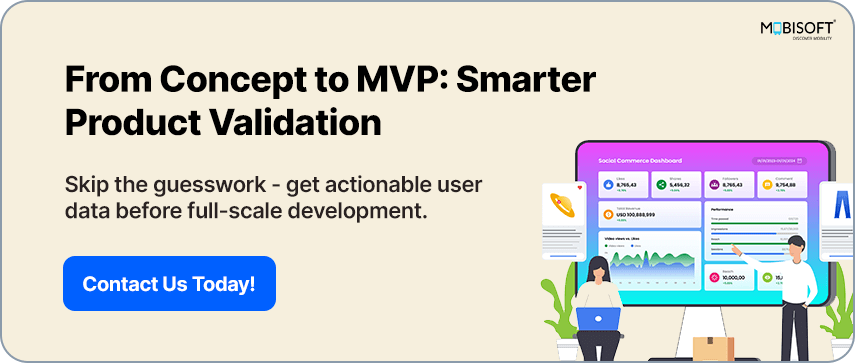

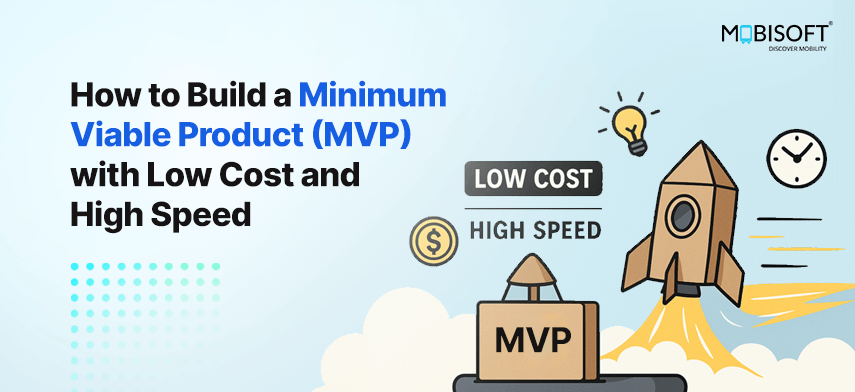


 May 9, 2025
May 9, 2025


